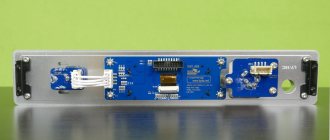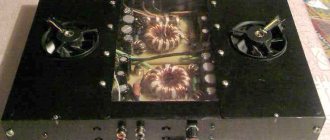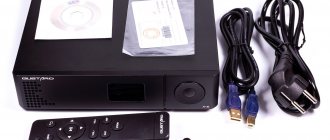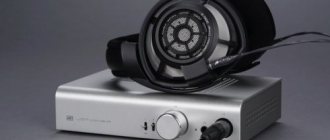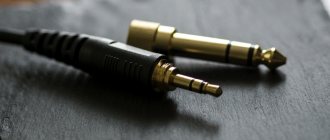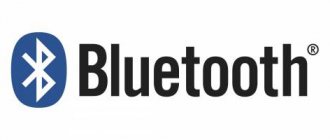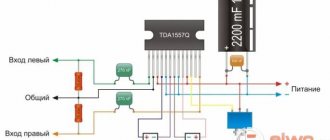Topping D10: a solid DAC with a replaceable amplifier
Today we will talk about the inexpensive desktop DAC Topping D10. The heart of this system is the ESS ES9018K2M, which allows you to process audio with a resolution of up to 384 kHz/32 bits and DSD up to 11.2 MHz. Among the main advantages, it is worth noting USB power supply, easy replacement of operational amplifiers and the ability to work as a digital signal source.
Characteristics
- USB: XMOS XU208
- DAC: ESS ES9018K2M
- OU: OPA2134 (replaceable)
- Audio resolution: up to 384 kHz/32 bit, DSD256
- Inputs: USB
- Outputs: OPT, COAX, RCA
- Power supply: 5V/0.5A from USB
- Dimensions: 103 mm x 146 mm x 37 mm
- Weight: 314 g
- OS: Windows 7,8,10; MACOS; Android, iOS
CHECK OUT THE CURRENT PRICE FOR Topping D10
Video version of the review
Unpacking and packaging
The DAC arrives in the familiar cardboard box with the brand name and Hi-Res certification logo. On the side there is the company’s Internet address, which you will need to download drivers or firmware updates. Yes, this device is being reflashed.
If you go to the corresponding page on the Internet, you will see that there are as many as three firmware versions listed there. The first few characters of the serial number will tell you which one is right for your device.
The D10's kit is sparse. Here we find a classic advertising brochure.
Operating instructions with measurements from the manufacturer.
There are also technical characteristics and a method for switching the device in various setups.
The only useful thing we have is a USB cable that connects the device to the PC. By the way, nutrition is also provided through it.
Design/Ergonomics
The D10's body is relatively small.
Completely made of metal and consists of two halves.
There is a Hi-Res Audio sticker on top of it.
And below there are four silicone legs. They are designed for better adhesion to the surface and, of course, not to scratch the table.
On the front we see a bunch of inscriptions and a screen. Surprisingly, the Topping D10 does not have a level control. For acoustics with a remote control or its own regulator, this is quite normal, but for studio monitors, adjusting the volume using the system is completely inconvenient. There is no headphone output either.
The screen itself is questionable, it simply shows the frequency and type of signal being played. So, it would be quite possible to do without it. Although, the font is certainly nice.
At the rear we have an RCA output for active speakers and two digital outputs: linear and coaxial. There is only one input here - USB. That is, Topping D10 can act not only as a DAC, but also as a digital signal source.
An alternative connection option is to use an external amplifier together with the D10, which, according to the manufacturer’s plans, should contain a level control and a headphone output.
Software
In principle, nothing needs to be installed for the DAC to work, but in this case the list of frequencies will not be complete and there will be no support for ASIO drivers. For those who are not in the know, the main advantage of ASIO is that it bypasses the Windows system mixer, and therefore does not have any external influence on the sound.
The software here is quite typical for XMOS: we select the delay time, bit depth and operating frequency.
As already mentioned in the specifications, Topping D10 works not only under Windows, Linux and Mac, but also under mobile systems such as Android and iOS. Consequently, we get a number of additional opportunities. Such as playing streaming services from a smartphone directly to your audio system, bypassing, for example, Bluetooth conversions.
To test with Android, I used OTG adapters: MicroUSB and Type C.
On the official website you can find not only drivers, but also firmware updates. Be careful here, the choice of firmware depends on the initial digits of the serial number. If you select the wrong file, you can brick the device. So, if you doubt or are afraid, then it is better to leave everything as it is. Moreover, in my case, the DAC came with the latest version 1.02.
During the entire testing of the D10, no more or less significant heating of the device was detected.
Parsing
Inside, in my opinion, the only interesting things are the removable op-amp and the presence of 4 frequency generators.
We initially know the DAC from the characteristics.
Unscrew the two upper bolts on each side and remove the corresponding part of the body.
Here you can see a small “snot” and, in fact, everything that the manufacturer promised us.
Carefully pry up the OPA2134 amplifier with tweezers and replace it with, for example, OPA1622.
The choice of the 2134 operational amplifier is highly questionable.
The first thing I tried was the AD826, but the sound was too bassy and dull. LM6172 gave better results, but the most pleasant sound was on OPA1622 - I left it.
Measurements
Based on the measurements, the result is ambiguous. The fact is that when connected to a smartphone, everything is just perfectly clean, but from my Acer Aspire 7 laptop on Windows 10 there is too much noise.
I tried all the steps: unplugged the laptop from the network, plugged it into other USB 2.0 ports. I even tried USB 3.0 and Type C to 3.1 via an adapter - zero effect. One could assume that the problem is in the cable or a defective copy, but with the phone the background is extremely clear. So it's all about nutrition. So, you should be careful here. Although in reality the existing 65 dB noise floor is certainly not audible, but, as they say, you can see them from the instruments.
Sound
Yamaha HS80M active near-field studio monitors were used to test the DAC. Reference: Focusrite Scarlett 2i2 and E-MU 0204.
The first thing I would like to note is that the D10 DAC does not add any additional musicality to the sound. Everything sounds quite detailed and coherent, but a little bland. Compared to the Scarlett 2i2, we lose a lot in emotional expression, but we gain a lot in transparency and nuance. Although, this may be influenced by the different composition of interconnect cables. I used a silver cable to test the Topping D10, and a regular copper cable for the Focusrite. Here it becomes obvious that the manufacturer chose the OPA2134 op-amp, which, naturally, was supposed to add a small blur and thereby increase the overall musicality of the path. Which is exactly what happened. As a result, I still changed my OPA1622 back to the complete 2134.
If we divide it by frequency, we would immediately like to note the very good transmission of the low-frequency component. The double bass creates a very rich and at the same time dynamic picture, going into depth exactly where it is required. The synthesis lacks a little bit of expression and punch.
Mid frequencies are perfectly clean, transparent, with a good bias towards micro-details. This is where it is best to listen to the music in depth, distinguishing the relative positioning of the musicians. The strings sound subtle and slightly aggressive, with all the bells they have. Lack of emotion is most easily noticed on vocals or wind instruments. I won’t say that it’s really that noticeable, but I compared it head-to-head, switching cables, and there is a difference. Of course, it can be varied with the help of replaceable op-amps, and this is where the complete amplifier showed itself best. Naturally, from what I had available.
The tall ones are in complete order: plates, brushes, bells - everything is in place and served quite separately. Of course, there is no ideal transparency, well, it’s a shame to ask for it from a device for $90, if it is not always available in devices for 600.
conclusions
Bottom line, the Topping D10 certainly has its drawbacks, but if we consider the DAC taking into account the price tag, then in this regard it is quite good. Clear transparent sound at mid frequencies, correct dynamic bass and very good highs for its class. Yes, he is slightly lacking in expressiveness, but this more than makes up for the presence of detail and the precision of scene construction that we have here. In its price segment, Topping D10 is definitely the king. No FX-Audio or Dilvpoetry even dreamed of such a level. Well, for those for whom this is not enough, there is the handsome DX3 Pro.
CHECK OUT THE CURRENT PRICE FOR Topping D10
Reviews of DACs Topping
So we are on different planets
That's what I'm telling you.
I'm also looking for something cheaper
Unnoticed. Accuface is clearly not cheaper.
Out of curiosity, I tried Chinese and Taiwanese electrolytes
I don't know why you tried them. Now, in my opinion, they are used more often in food chains. And so - polymer.
Out of curiosity, I tried Chinese and Taiwanese electrolytes. I still remember how many years have passed.
Maybe this is the reason? You don’t even take into account that a lot could have changed since then.
Spare parts costing a few cents, not dollars, do not sound a priori
This is how your bias has developed. You think that everyone is lying to you, except Accuface and other high-end companies, they are slipping you cheap Chinese fake parts. And it can’t even occur to you that the Chinese can afford to supply real ELNA and WIMA, for a fucking simple reason - they don’t have such huge markups for every sneeze, there are no bosses who think that the buyer should be torn off for a mug on the face three skins. Do you really think that all Chinese equipment manufacturers are so idiotic that they will deceive ALL customers? And other idiots, who count in the millions, for some reason write them praising reviews, and don’t spit and write everywhere that Chinese DACs are bullshit with bad sound? And that in this thread there are also such idiots that they listened and even bought for themselves, and are happy, but you, who did not listen, know them all much better! Like: I didn’t listen to this myself, but I condemn it...
If current Cambridge were at the level of Nada in the late 90s...
Yeah, yeah, another myth. Very common at one time. NAD is our everything! I remember, of course, the Japanese sound is like absolutely shit, and all that, you need an English sound. Nad is Canadian, but it still sounds English. I didn’t understand this then, I thought, well, maybe I don’t understand something? I went and listened to this vaunted NAD. This happened in 1998 or 1999. And he heard, complete with B&W speakers, what the doctor ordered for him. Is it an English sound? The impression was: loud, rude, straightforward, and most importantly - dirty sound. Nothing outstanding for sure! Then the buyer was connected to different cables, silver-plated and thick copper, but the sound continued to stubbornly remain disgusting! I then stood and was surprised. I thought, damn, these are NAD! Then I thought that the speakers were probably to blame. Like, they didn’t warm up. I went and listened to the same B&W. I was connected to a Japanese amplifier. And you know, they sang very well, but there wasn’t enough bass. But there was definitely no dirt, a clear sound. I even remember listening to female vocals! Now that myth has been forgotten, and so has the “Japanese sound”. Accuface, isn't it a Japanese sound? But Cambridge has a Chinese sound, although the company is English. It's funny to read all this. There was and still is nothing behind this except naked bias.
